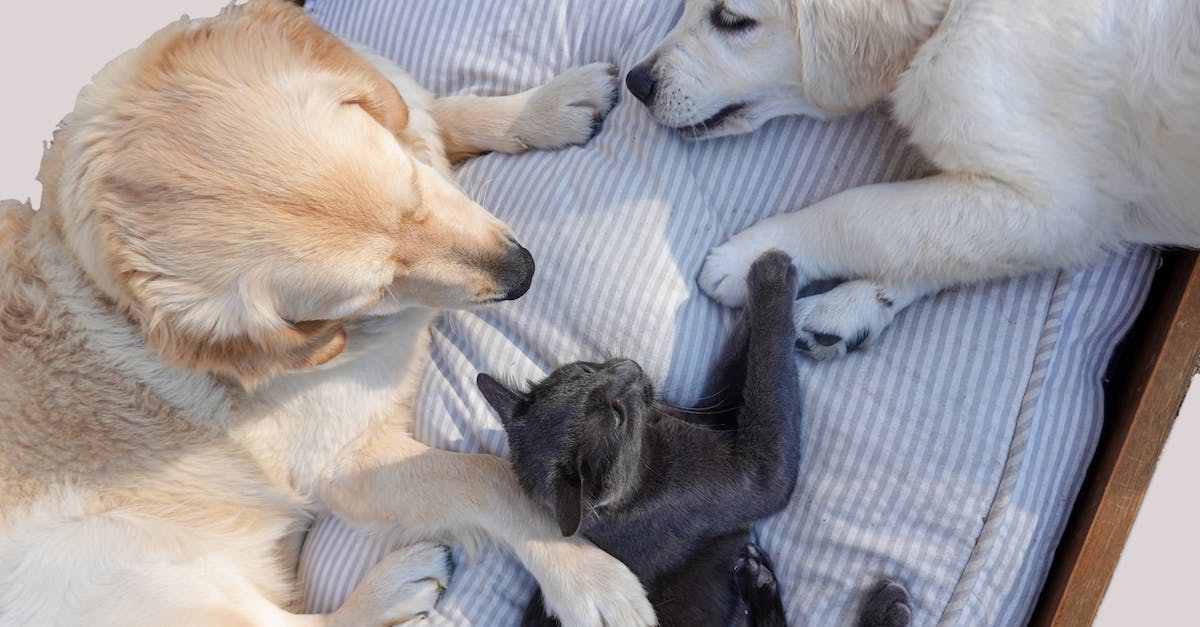Business
Guide to Introducing Cats to Dogs: Essential Steps for a Harmonious Transition
Learn how to successfully introduce cats to dogs with these essential steps. Create a safe and harmonious environment by designating separate spaces, swapping scents, and using physical barriers. Understand cat and dog body language to gauge their comfort levels during the introduction. Supervise and intervene if needed, and be patient throughout the process. Address potential challenges like aggression and territorial behavior. Nurture a positive relationship through controlled interactions, positive reinforcement, and respecting boundaries. Create a strong and lasting bond between your pets.
Published
1 year agoon

Are you a proud cat owner who’s considering adding a canine companion to the mix? Introducing cats to dogs can be a delicate process, but with the right approach, it’s absolutely possible for them to become the best of friends. In this article, I’ll share my expert tips on how to successfully introduce cats to dogs, ensuring a harmonious and peaceful coexistence between your furry friends.
Bringing a new pet into your home is always exciting, but it’s important to take the necessary steps to ensure a smooth introduction. Cats and dogs have different personalities and communication styles, so it’s crucial to create a positive and gradual introduction process. From setting up a safe space for your cat to understanding their body language, I’ll guide you through every step of the way.
By following the advice in this article, you’ll be equipped with the knowledge and strategies to make the introduction between your cat and dog a success. So, if you’re ready to create a loving and peaceful environment for your pets, let’s dive in and discover how to introduce cats to dogs.
Preparing Your Home for a Smooth Transition
When introducing a new cat to your resident dog, it’s crucial to create a safe and harmonious environment for both of them. Here are some essential steps to prepare your home for a smooth transition:
- Designate separate spaces: Before bringing the new cat home, make sure you have designated spaces for each pet. This will help them feel secure and minimize potential conflicts. Allocate separate rooms or areas where each pet can retreat to when they need some personal space.
- Provide hiding spots: Cats often feel more confident when they have hiding spots. Ensure there are plenty of safe and cozy spaces where the cat can go if they feel overwhelmed. This can include cat trees, shelves, or even a comfy box with a blanket.
- Scent swapping: Help your pets get accustomed to each other’s scent before their initial face-to-face introduction. Rub a towel or cloth on each pet’s face and then exchange them so they can get familiar with each other’s scent. This can help reduce anxiety and make the actual meeting smoother.
- Set up litter boxes and feeding stations: It’s important to provide separate resources for each pet to avoid potential conflicts. Place multiple litter boxes in different areas of the house and ensure there is enough distance between their food and water bowls.
- Use pet gates or baby gates: Consider using pet gates or baby gates to create physical barriers between the cat and dog during the initial stages of introduction. This allows them to see each other without direct contact, helping them adjust gradually to each other’s presence.
Remember, every pet is different, and their introduction process may vary. Take your time and go at a pace that suits both your cat and dog. By following these steps to prepare your home, you’ll create a calm and stress-free environment for their initial meeting.
Creating a Safe Space for Your Cat
When introducing a new cat to your resident dog, it’s crucial to create a safe and secure environment for your feline friend. This will help alleviate stress and promote a positive experience for both pets. Here are some important steps to follow when creating a safe space for your cat:
1. Designate separate spaces: Ensure that your cat has their own designated area where they can retreat to and feel safe. This can be a spare room, a quiet corner of the house, or even a cozy cat tree. Creating a separate space allows your cat to have some alone time and helps prevent any potential confrontations with your dog.
2. Provide hiding spots: Cats are naturally inclined to find hiding spots when they feel threatened or overwhelmed. Make sure to provide plenty of hiding spots for your cat throughout the house. This can be in the form of covered cat beds, cardboard boxes, or even strategically placed furniture. These hiding spots will give your cat a sense of security and a place to retreat to if they feel the need.
3. Scent swapping: Before the actual face-to-face introduction, it’s essential to familiarize your pets with each other’s scent. This can be done by swapping bedding or rubbing a cloth on one pet’s scent glands and placing it near the other pet’s sleeping area. This process helps both pets become acquainted with each other’s scent, making the actual introduction less stressful.
4. Separate litter boxes and feeding stations: Each pet should have their own designated litter box and feeding station. Dogs and cats have different dietary needs, and having separate areas for these activities helps minimize any potential conflicts or stress between them. It’s important to ensure that these areas are easily accessible for each pet and located in quiet, low-traffic areas of the house.
5. Use physical barriers: During the initial stages of introducing your cat to your dog, it’s helpful to use pet gates or baby gates as physical barriers. This allows both pets to see and smell each other without having direct contact. Gradually increase the time they spend near each other, always monitoring their behavior closely. This gradual exposure helps them acclimate to each other’s presence and reduces the risk of any sudden negative interactions.
Familiarizing Your Dog with Cat’s Presence
Introducing a new cat to your resident dog requires careful and strategic planning to ensure a smooth transition and the development of a harmonious relationship between the two pets. One crucial step in the process is to familiarize your dog with the presence of the new cat.
Here are some effective strategies to help your dog acclimate to the presence of a new feline family member.
- Scent Swapping: Start by exchanging scents between the cat and the dog. Rub a soft cloth or towel on the cat and then place it near your dog’s resting area. Repeat this process with your dog and place the towel with their scent near the cat’s hiding spot. This scent swapping helps to familiarize both pets with each other’s scent, making the initial introduction less intimidating.
- Visual Introduction: Before allowing direct interaction between the two, you can introduce them using a barrier, such as a baby gate or pet gate. This allows them to see each other without the risk of any negative interactions. It’s important to monitor their behavior during this time and observe any signs of aggression or fear.
- Positive Reinforcement: Associate positive experiences with the presence of the cat. Reward your dog with treats or praise whenever they show calm and non-threatening behavior in the cat’s vicinity. This positive reinforcement can help create a positive association with the cat and encourage friendly behavior.
- Supervised Interactions: Once your dog appears comfortable and relaxed around the cat, you can start supervised interactions between them. Keep the initial encounters short and gradually increase the duration over time. Always maintain control of the situation and be ready to separate them if necessary.
- Respect Personal Space: It’s essential to respect the personal space of both pets during the introduction process. Avoid forcing interactions and allow them to approach each other at their own pace. This will help build trust and prevent any potential conflicts.
Remember, every dog and cat is unique, and the introduction process may take different amounts of time for each individual. It’s important to be patient, observe their behavior closely, and adjust the pace as needed to ensure a positive and stress-free transition for both pets.
By gradually familiarizing your dog with the presence of the new cat through scent swapping, visual introductions, positive reinforcement, supervised interactions, and respecting personal space, you can lay the foundation for a successful relationship between your pets.
Introducing Cats and Dogs Gradually
When it comes to introducing cats and dogs, it’s essential to take things slow and gradual. Rushing the process can lead to stress and potential conflicts between your pets. By following these steps, you can help create a positive and peaceful environment for their first interactions.
- Scent swapping: One of the first things you can do is to swap scents between your cat and dog. Take a cloth or towel and rub it on one pet, then place it near the other pet’s bed or living area. This helps familiarize them with each other’s scent, which is an important part of the introduction process.
- Visual introduction: Once the pets are comfortable with each other’s scent, it’s time for a visual introduction. This can be done by using a pet gate or carrier to separate them while allowing them to see each other. Observe their reactions closely and look for signs of fear or aggression. If they remain calm, you can move on to the next step.
- Positive reinforcement: Rewarding your pets with treats and praise during the introduction is key. This positive reinforcement helps them associate each other’s presence with something enjoyable. Make sure to offer treats and affection to both pets to avoid jealousy or resentment.
- Supervised interactions: Gradually increase the time and proximity of the interactions under close supervision. Start with short periods of supervised time together and gradually lengthen the duration as they become more comfortable. Always be present to intervene if any signs of tension or aggression occur.
- Respecting personal space: Both cats and dogs need their personal space. Make sure each pet has a safe area where they can retreat to if they feel overwhelmed. Provide separate litter boxes, feeding stations, and hiding spots for the cat. This will help alleviate stress and create a sense of security for both pets.
Remember, introducing cats and dogs can take time and patience. Every pet is different, and they may adjust at their own pace. By slowly introducing them and offering positive experiences, you can lay the foundation for a peaceful and harmonious relationship between your cat and dog.
Understanding Cat and Dog Body Language
Understanding the body language of both cats and dogs is crucial when introducing them to each other. It allows you to assess their level of comfort and helps prevent any potential conflicts. Here are some key body language cues to look out for when introducing cats and dogs:
Cats:
- Purring: This is a sign of contentment and relaxation. If your cat is purring, it generally means they are feeling comfortable and safe.
- Tail position: A relaxed, vertical tail indicates that a cat is calm and confident. A puffed-up tail or a tail held low and tucked between the legs may indicate fear or aggression.
- Ear position: Forward-facing ears suggest that a cat is curious and interested. Flattened ears indicate fear or aggression.
- Eye contact: Direct eye contact from a cat can be seen as confrontational. Slow blinking or avoiding eye contact signifies relaxation and trust.
Dogs:
- Wagging tail: A dog wagging its tail with loose, relaxed motions typically indicates friendliness and excitement. However, a stiff, high wagging tail could be a sign of arousal or potential aggression.
- Body posture: A relaxed and loose body posture with a slightly curved tail suggests a dog is calm and open to interaction. On the other hand, a tensed body with a raised tail and upright ears indicates alertness and potential aggression.
- Licking lips: Dogs often lick their lips when they are feeling stressed or anxious. It’s important to observe whether the lip licking is a result of nervousness or anticipation.
- Yawning: Dogs may yawn when they are feeling stressed or uncomfortable. It can be a sign that they need some space or a break from the situation.
By understanding these body language cues, you can better gauge the comfort levels of both your cat and dog during their introduction. Pay close attention to their signals and provide them with a safe and stress-free environment. Remember, each pet is unique, so take the time to observe and respond to their needs accordingly.
Supervising Initial Interactions
Now that you have followed the necessary steps to prepare your home and familiarize your cat and dog with each other’s scent, it’s time to start supervising their initial interactions. This is an important stage in the introduction process as it allows you to gauge the comfort levels of both pets and ensure their safety.
When supervising your cat and dog’s interactions, it’s important to understand their body language. Just like humans, cats and dogs have their ways of communicating their emotions and intentions. By observing their cues, you can better anticipate any potential issues and intervene if necessary.
Here are some key body language cues to look out for in both cats and dogs:
Cats:
- Tail position: A relaxed, straight tail indicates a calm cat, while a puffed-up or swishing tail can indicate fear or aggression.
- Ear position: Forward-facing ears are a sign of interest or contentment, while flattened ears can indicate stress or agitation.
- Eye contact: Dilated pupils or staring can be signs of fear or aggression, whereas a slow blink is a friendly gesture.
- Body posture: A relaxed, loose body posture suggests comfort, while a tense or crouched posture can be a sign of fear or aggression.
Dogs:
- Tail position: A slow wagging tail with a relaxed body suggests a friendly dog, while a high or stiffly wagging tail can indicate excitement or tension.
- Ear position: Erect ears suggest attentiveness, while flattened or pinned-back ears can signal fear or submission.
- Eye contact: Direct eye contact can be a sign of dominance or potential aggression, while averting the gaze or softening the eyes is a more relaxed gesture.
- Lip licking and yawning: These can be stress signals in dogs, indicating that they are uncomfortable or anxious.
By paying close attention to these cues, you can better evaluate the dynamics between your cat and dog during their initial interactions. If you notice any signs of tension or discomfort, it’s important to separate them and give them some space. This will allow them to calm down and prevent any potential conflicts.
Remember, it’s crucial to go at a pace that suits both your cat and dog. Some pets may have an easier time adjusting to each other, while others may need more time. Be patient and provide positive reinforcement through treats and praise when they display calm and friendly behavior.
Addressing Challenges and Potential Issues
Introducing a new cat to your resident dog can sometimes come with its own set of challenges and potential issues. Here are a few things to keep in mind as you navigate this process:
- Aggression: It’s not uncommon for dogs to display aggression towards cats, especially if they haven’t been properly socialized or have a strong prey drive. Similarly, some cats may react aggressively towards dogs, feeling threatened by their presence. If you notice any signs of aggression from either pet, it’s important to address it immediately. Consult with a professional behaviorist or trainer who can provide guidance and help you manage and modify any aggressive behaviors.
- Stress and Anxiety: Introducing a new pet into the home can cause stress and anxiety for both the cat and the dog. They may experience fear, nervousness, or become overwhelmed by the unfamiliar territory or the presence of another animal. To alleviate their anxiety, provide each pet with their own safe space, complete with hiding spots and familiar items, such as blankets or toys. This will give them a sense of security and allow them to retreat to a quiet area when they need some alone time.
- Territorial Behavior: Dogs and cats are naturally territorial animals. When introducing a new pet, trying to claim the same space can lead to conflicts. Make sure each pet has their own designated areas, including separate feeding stations and litter boxes. This will help prevent territory disputes and give each pet a sense of ownership and control.
- Different Energy Levels: Dogs and cats often have different energy levels and play styles. Some dogs may be exuberant and boisterous, while cats tend to be more cautious and reserved. It’s important to ensure that their interactions are supervised and controlled. If the dog’s energy is overwhelming for the cat, redirect their attention with toys or treats to provide a positive distraction. This will prevent the cat from feeling overwhelmed or threatened.
- Unequal Power Dynamics: Dogs are generally bigger and more powerful than cats, which can create an imbalance of power in their interactions. It’s crucial to monitor their body language and intervene if necessary to prevent any harm to either pet. If you notice the dog displaying dominant behaviors, such as mounting or aggressively barking at the cat, redirect their attention and reinforce positive behavior.
Nurturing a Positive Relationship
When introducing cats and dogs, it’s important to cultivate a positive relationship between the two pets. This process requires patience, time, and a deep understanding of their individual needs and behaviors. Here are some key strategies to help foster a harmonious bond:
1. Controlled interactions: Start by allowing brief and controlled interactions between your cat and dog while closely supervising them. Keep the dog on a leash and use a pet gate or baby gate to create a physical barrier. This allows them to see and smell each other while preventing any potential conflicts or injuries. Gradually increase the duration of these interactions as both pets become more comfortable.
2. Positive reinforcement: Reward both the cat and dog with treats, praise, and affection during their interactions. This helps create positive associations with each other’s presence and encourages them to see each other as something enjoyable. Providing treats simultaneously can also help them associate each other’s presence with something positive.
3. Separate but equal attention: Ensure that both your cat and dog receive equal attention and affection from you. This helps prevent any feelings of jealousy or competition between them. By giving each pet individual quality time, you reinforce their bond with you and reassure them that they are still loved and valued.
4. Create shared experiences: Engage both your cat and dog in activities that they enjoy, such as interactive play sessions or supervised outdoor adventures. These shared experiences can help them associate positive feelings with each other’s company and build a sense of camaraderie.
5. Respect their boundaries: Every pet has their own comfort levels and boundaries. It’s important to respect these limits and never force them into situations that make them anxious or fearful. Allow each pet to retreat to their safe space whenever they need time alone. Gradually, as they become more familiar with each other and build trust, their boundaries may expand naturally.
Remember, building a positive relationship between cats and dogs takes time and effort. Be patient, observe their body language, and adjust your approach accordingly. With consistent, positive reinforcement and a mindful approach, you can create a strong and lasting bond between your furry companions.
Conclusion
Introducing a new cat to your resident dog can be a challenging process, but with the right steps and strategies, you can create a safe and harmonious environment for both pets. By designating separate spaces, providing hiding spots, and scent swapping, you can help familiarize them with each other’s presence. Setting up separate litter boxes and feeding stations ensures that they have their own personal spaces. Using pet gates or baby gates as physical barriers during the initial stages of introduction can help ease the process.
Understanding cat and dog body language is crucial in gauging their comfort levels during their initial interactions. By paying close attention to cues such as tail position, ear position, and eye contact, you can evaluate their dynamics and intervene if necessary. Supervising their interactions and being patient throughout the process is essential.
Addressing potential challenges like aggression, stress, and territorial behavior is important. By following tips such as controlled interactions, positive reinforcement, and equal attention, you can foster a positive relationship between your cat and dog.
Remember, introducing a new cat to your resident dog takes time and patience. By following these steps and strategies, you can help create a strong and lasting bond between your pets.
How can I prepare my home for introducing a new cat to my resident dog?
To prepare your home for introducing a new cat to your resident dog, start by designating separate spaces for each pet. Provide hiding spots for the cat and use scent swapping techniques to familiarize them with each other’s scent. Set up separate litter boxes and feeding stations. Use pet gates or baby gates as physical barriers during the initial stages of introduction. Take your time and go at a pace that suits both your cat and dog to create a calm and stress-free environment for their initial meeting.
How can I familiarize my dog with the presence of the new cat?
To familiarize your dog with the presence of the new cat, it’s important to understand cat and dog body language. Look for cues such as tail position, ear position, eye contact, wagging tail, body posture, licking lips, and yawning. By understanding these cues, you can gauge the comfort levels of both your cat and dog and provide them with a safe and stress-free environment. Supervise their initial interactions closely and intervene if necessary.
What challenges might arise during the introduction process?
During the introduction process, you may encounter challenges such as aggression, stress and anxiety, territorial behavior, different energy levels, and unequal power dynamics. It’s important to address these challenges and ensure a smooth transition for both pets. Seek professional help if needed and consider implementing strategies such as controlled interactions, positive reinforcement, equal attention, creating shared experiences, and respecting their boundaries to foster a positive relationship between the cat and dog. Be patient and go at a pace that suits both pets throughout the process.
With over a decade of experience in the tech industry, Priya Sharma is a seasoned software engineer and tech blogger. She holds a Bachelor's degree in Computer Science from the Indian Institute of Technology (IIT) and has been a key contributor to cutting-edge projects in artificial intelligence and software development.

You may like
Mobility Scooter


Sideways Market: Navigating the Fluctuating Trends
Understanding Market Volatility Market volatility refers to the degree of variability in the price of a financial instrument within a...


Enhance Your iPhone with Adorable Cute Wallpapers
Looking to jazz up your iPhone screen with some cuteness? Discover the impact of adorable wallpapers on your device's look...


Glow Berry Prime: The Science Behind its Skincare Revival
Discover the transformative power of Glow Berry Prime in skincare with its potent blend of 20% Vitamin C, 2% Hyaluronic...


Glov Beauty: Eco-Friendly Products Review | Glov Beauty Reviews
Discover Glov Beauty's eco-friendly products like the Glov On-The-Go set with 500+ uses and the gentle exfoliation offered by the...


Unlocking Drake’s FPS Lyrics: How Gaming Influences His Music
Discover how Drake's lyrics in the first-person shooter-inspired track "War" reflect the influence of FPS games on his music. With...


Defeating a Fire-Breathing Dragon: Strategies for Mage Survival
Prepare yourself for an intense battle as we explore how to face a dragon capable of reaching temperatures over 2000°F....


Exploring Student Life at Glitties Eckerd College
Discover the dynamic student experience at Glitties Eckerd College with a plethora of club options, competitive sports, and community service...


Discover Success Stories with Money6x Real Estate Strategy
Discover the lucrative world of real estate investing with Money6x strategy! Uncover real-life success stories of investors achieving impressive 8-12%...


Get an Inside Look at Julion Alvarez’s 2024 USA Tour
Discover the meticulous planning behind Julion Alvarez's 2024 USA tour! Dive into the world of setlist curation, choreography design, and...


Enhancing Connections through Diversity & Active Listening
Learn how treating peers with empathy and actively listening can enhance relationships and boost innovation. The article emphasizes the significance...